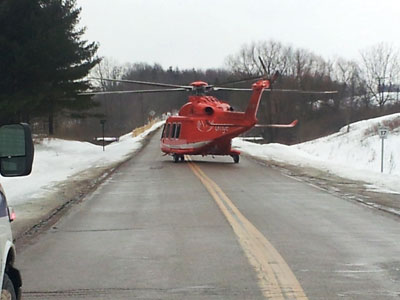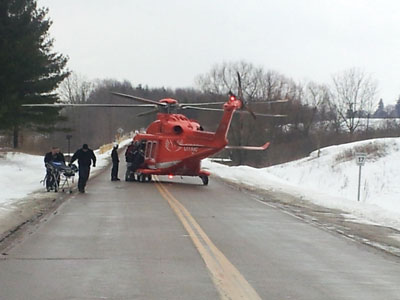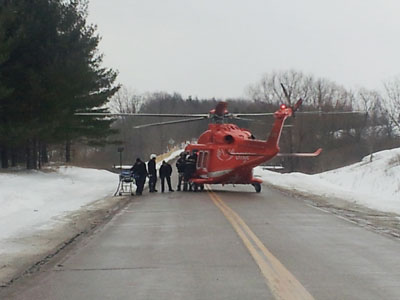
Features
Training
Back to Basics: May 2013
On Feb. 24, at about 10:30 a.m., we responded to a call for a vehicle accident. Updated information provided en route informed us that a vehicle had collided with a train at a land railway crossing.
April 23, 2013
By Mark van der Feyst
On Feb. 24, at about 10:30 a.m., we responded to a call for a vehicle accident. Updated information provided en route informed us that a vehicle had collided with a train at a land railway crossing. Once on scene, we confirmed that a single vehicle was involved with the train. The vehicle had been hit very hard, causing it to bounce off of a few rail cars about 12 metres (40 feet) down the rail line, before resting on the rail-line embankment with a portion of the vehicle under the rail car.
 |
|
| Photo 1: In February, a vehicle collided with a train at a high speed in southwestern Ontario. The lone occupant of the vehicle was suspected of having serious internal injuries; this prompted EMS to request an air ambulance to respond to the scene. Photos courtesy of R. Kienselokker
|
Any motor vehicle accident will have fluids leaking from the vehicles involved. A spark or other source of ignition can lead to a fire. As such, a hoseline was pulled off the apparatus and charged so that, in the case of a sudden fire, responding crew members would have ready access to water protection. This particular vehicle accident had plenty of gasoline, diesel and other car fluids on the ground around where personnel were working. Extrication equipment was also removed from the fire apparatus and placed at a staging area near the vehicle.
Inside the vehicle was a lone occupant in the driver’s seat who had sustained visible facial and head trauma. Upon their arrival, the paramedics and site supervisor conducted an assessment to determine the extent and nature of the driver’s injuries. Because the vehicle collided with the train at a high speed, serious internal injuries were suspected; this prompted EMS to request an air ambulance to respond to the scene (see photo 1).
No matter where you are in Canada, or what type or size of fire department you work for, there is a good chance that you could have an air ambulance respond to and land at your scene. When this occurs, there are some important safety considerations that need to be implemented to keep everyone safe on scene.
The air ambulance service trains regularly with the fire service to ensure that fire personnel are familiar with the protocols for helicopter landing and that first responders are comfortable working around an air ambulance. It might be a good idea to contact the air ambulance provider in your region to set up training time as part of your annual training plan.
 |
|
| Photo 2: An air ambulance crew member, pictured here in a white flight helmet, will ensure that it is safe to approach the helicopter, and will escort rescuers to and from the helicopter. |
When it arrives, the air ambulance will conduct its own scene survey, which will involve a low circular flight pattern over the incident scene. This survey is done to make sure the landing zone is the appropriate size, that there are no immediate hazards in the vicinity (such as electrical wires) and also to let everyone know that the air ambulance is going to land soon. An appropriate landing zone should measure 45.7 metres by 45.7 metres (150 feet by 150 feet). The ground needs to be solid – asphalt pavement or a concrete roadway – so that the helicopter will not sink into it when it lands. If the helicopter pilot determines that the landing zone is not adequate, he or she will choose an area that is.
The pilot will be in constant communication with a landing-zone officer prior to landing. The landing-zone officer can be any firefighter, police officer or EMS personnel. If you are chosen for this task, be sure to communicate clearly and effectively with the pilot. You will need to identify yourself as the landing-zone officer so that the pilot will know with whom he or she is speaking. Give the pilot precise directions to the landing zone and any of your observations as the pilot is landing the air ambulance so that he or she knows exactly what to expect on the ground. Observations can include landmarks around the landing area, overhead hazards and wind direction.
Before the helicopter lands, all loose debris needs to be secured or it can become a projectile; this includes any uncharged hoselines, extraction equipment that has been taken off of the fire apparatus and any other small objects. Any projectile can easily cause injury to responding personnel on the ground, as well as cause mechanical damage to the helicopter’s engine if debris is sucked into the engine’s intakes.
When the helicopter is landing, there will be downwash produced by the rotors. The downwash can produce winds as fast as 160 kilometres per hour (100 miles per hour), blowing anything in their path. Eye protection needs to be worn. Case in point: At our accident scene, when the helicopter was landing, the downwash produced a whiteout condition. All personnel had to turn away momentarily to prevent flying snow particles from entering their eyes. The same downwash effect is produced when the helicopter takes off.
It is also a good idea to implement a safety zone around the helicopter. When the helicopter is landing and on the ground, a safe distance of 61 metres (200 feet) is recommended for all personnel and 45.7 metres (150 feet) for vehicles. This safe distance needs to be maintained until you are directed to approach the helicopter by the pilot or a crew member. If you need to approach the helicopter, keep a direct line of sight with the pilot and make sure that he or she sees you.
If you are assisting EMS with the transfer of the patient to the helicopter, an air ambulance crew member will escort you to the helicopter. In photo 2, you can see the crew member in the white flight helmet. He or she will ensure that it is safe to approach the helicopter, and will escort you to the helicopter and then direct you away from the helicopter when it comes time to leave.
 |
|
| Photo 3: EMS personnel are hunched down while walking under the canopy of the rotating blades, which are the most serious hazard for approaching personnel. |
In photo 3, you can see two EMS personnel moving away from the helicopter. Notice how they are positioned: they are hunched down while walking under the canopy of the rotating blades. The blades of the helicopter are the most dangerous part for any approaching personnel.
Once on the ground, the pilot will sometimes keep the helicopter’s engine running and the blades spinning at an idle speed so the helicopter can quickly depart. When this is the case, you will need to protect your head by staying low when approaching the helicopter.
Always approach the helicopter directly from the sides – not along the tail portion. The rear and front areas are the most dangerous zones for two reasons: first, because the pilot cannot see you from the rear, where there is also a spinning tail rotor, and second, because the blades in the front are tilted forward, which does not leave much space in which to approach.
More information about helicopter safety can be obtained from your local air ambulance provider. It will sometimes even offer practical training to personnel so that they can become comfortable and confident when working around a helicopter.
Mark van der Feyst is a 14-year veteran of the fire service and works
for the City of Woodstock Fire Department in Ontario. Mark instructs in
Canada, the United States and India and is a local-level suppression
instructor for the Pennsylvania State Fire Academy and an instructor for
the Justice Institute of B.C. E-mail Mark at Mark@FireStarTraining.com
Print this page
Advertisement
- Fire that destroyed Truro landmark deemed accidental
- Discarded cigarette may have started Courtenay fire